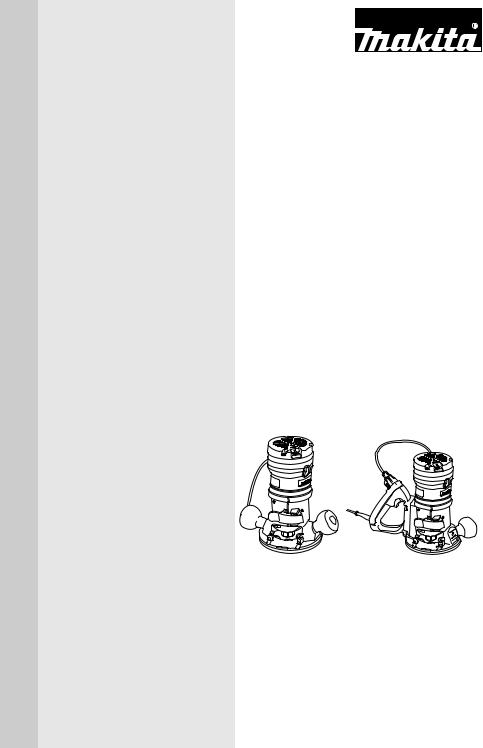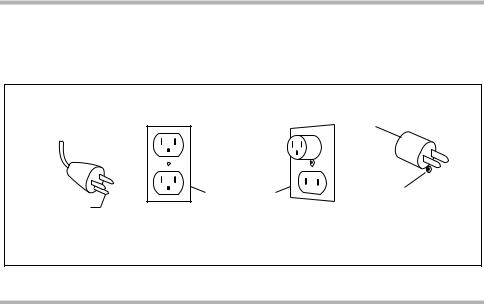Makita RF1100, RF1101, RD1100, RD1101 User Manual

Router
MODEL RF1100/RF1101
MODEL RD1100/RD1101
003648
I N S T R U C T I O N M A N U A L
 WARNING:
WARNING:
For your personal safety, READ and UNDERSTAND before using. SAVE THESE INSTRUCTIONS FOR FUTURE REFERENCE.
w w w . m a k i t a t o o l s . c o m

SPECIFICATIONS
Model |
RF1100 |
RF1101 |
RD1100 |
RD1101 |
|
|
|
|
|
Collet chuck capacity |
|
1/2” and 1/4” |
|
|
|
|
|
|
|
No load speed (RPM) |
24,000/min. |
8,000 - 24,000/min. |
24,000/min. |
8,000 - 24,000/min. |
|
|
|
|
|
Overall height |
|
223 mm (8-3/4”) |
|
|
|
|
|
|
|
Net weight |
3.2 kg (7.1 lbs) |
3.6 kg (7.9 lbs) |
||
|
|
|
|
|
•Manufacturer reserves the right to change specifications without notice.
•Specifications may differ from country to country.
GENERAL SAFETY RULES |
USA001-2 |
(For All Tools)
 WARNING:
WARNING:
Read and understand all instructions. Failure to follow all instructions listed below, may result in electric shock, fire and/or serious personal injury.
SAVE THESE INSTRUCTIONS
Work Area
1.Keep your work area clean and well lit.
Cluttered benches and dark areas invite accidents.
2.Do not operate power tools in explosive atmospheres, such as in the presence of flammable liquids, gases, or dust. Power tools create sparks which may ignite the dust or fumes.
3.Keep bystanders, children, and visitors away while operating a power tool. Distractions can cause you to lose control.
Electrical Safety
4.Grounded tools must be plugged into an outlet properly installed and grounded in accordance with all codes and ordinances. Never remove the grounding prong or modify the plug in any way. Do not use any adaptor plugs. Check with a qualified electrician if you are in doubt as to whether the outlet is properly grounded. If the tools should electrically malfunction or break down, grounding provides a low resistance path to carry electricity away from the user.
2

5.Avoid body contact with grounded surfaces such as pipes, radiators, ranges and refrigerators. There is an increased risk of electric shock if your body is grounded.
6.Do not expose power tools to rain or wet conditions. Water entering a power tool will increase the risk of electric shock.
7.Do not abuse the cord. Never use the cord to carry the tools or pull the plug from an outlet. Keep cord away from heat, oil, sharp edges or moving parts. Replace damaged cords immediately. Damaged cords increase the risk of electric shock.
8.When operating a power tool outside, use an outdoor extension cord marked “W-A” or “W”. These cords are rated for outdoor use and reduce the risk of electric shock.
Personal Safety
9.Stay alert, watch what you are doing and use common sense when operating a power tool. Do not use tool while tired or under the influence of drugs, alcohol, or medication. A moment of inattention while operating power tools may result in serious personal injury.
10.Dress properly. Do not wear loose clothing or jewelry. Contain long hair. Keep your hair, clothing, and gloves away from moving parts. Loose clothes, jewelry, or long hair can be caught in moving parts.
11.Avoid accidental starting. Be sure switch is off before plugging in. Carrying tools with your finger on the switch or plugging in tools that have the switch on invites accidents.
12.Remove adjusting keys or wrenches before turning the tool on. A wrench or a key that is left attached to a rotating part of the tool may result in personal injury.
13.Do not overreach. Keep proper footing and balance at all times. Proper footing and balance enables better control of the tool in unexpected situations.
14.Use safety equipment. Always wear eye protection. Dust mask, non-skid safety shoes, hard hat, or hearing protection must be used for appropriate conditions. Ordinary eye or sun glasses are NOT eye protection.
Tool Use and Care
15.Use clamps or other practical way to secure and support the workpiece to a stable platform. Holding the work by hand or against your body is unstable and may lead to loss of control.
16.Do not force tool. Use the correct tool for your application. The correct tool will do the job better and safer at the rate for which it is designed.
17.Do not use tool if switch does not turn it on or off. Any tool that cannot be controlled with the switch is dangerous and must be repaired.
18.Disconnect the plug from the power source before making any adjustments, changing accessories, or storing the tool.
Such preventive safety measures reduce the risk of starting the tool accidentally.
19.Store idle tools out of reach of children and other untrained persons. Tools are dangerous in the hands of untrained users.
20.Maintain tools with care. Keep cutting tools sharp and clean. Properly maintained tools with sharp cutting edges are less likely to bind and are easier to control.
21.Check for misalignment or binding of moving parts, breakage of parts, and any other condition that may affect the tools operation. If damaged, have the tool serviced before using. Many accidents are caused by poorly maintained tools.
22.Use only accessories that are recommended by the manufacturer for your model. Accessories that may be suitable for one tool, may become hazardous when used on another tool.
3

SERVICE
23.Tool service must be performed only by qualified repair personnel. Service or maintenance performed by unqualified personnel could result in a risk of injury.
24.When servicing a tool, use only identical replacement parts. Follow instructions in the Maintenance section of this manual.
Use of unauthorized parts or failure to follow Maintenance instructions may create a risk of electric shock or injury.
USE PROPER EXTENSION CORD: Use only three-wire extension cords that have threeprong grounding-type plugs and three-pole receptacles that accept the tool’s plug. Make sure your extension cord is in good condition. Replace or repair damaged or worn cord immediately. When using an extension cord, be sure to use one heavy enough to carry the current your product will draw. An undersized cord will cause a drop in line voltage resulting in loss of power and overheating. Table 1 shows the correct size to use depending on cord length and nameplate ampere rating. If in doubt, use the next heavier gage. The smaller the gage number, the heavier the cord.
Table 1: Minimum gage for cord
Ampere Rating |
Volts |
|
Total length of cord in feet |
|
||||
120 V |
25 ft. |
|
50 ft. |
100 ft. |
|
150 ft. |
||
|
|
|
|
|||||
|
|
|
|
|
|
|
|
|
More Than |
Not More Than |
|
|
|
AWG |
|
|
|
|
|
|
|
|
|
|
|
|
0 |
6 |
|
18 |
|
16 |
16 |
|
14 |
|
|
|
|
|
|
|
|
|
6 |
10 |
|
18 |
|
16 |
14 |
|
12 |
|
|
|
|
|
|
|
|
|
10 |
12 |
|
16 |
|
16 |
14 |
|
12 |
|
|
|
|
|
|
|
|
|
12 |
16 |
|
14 |
|
12 |
Not Recommended |
||
|
|
|
|
|
|
|
|
|
GROUNDING INSTRUCTIONS
This tool should be grounded while in use to protect the operator from electric shock. The tool is equipped with a three-conductor cord and three-prong grounding type plug to fit the proper grounding type receptacle. The green (or green and yellow) conductor in the cord is the grounding wire. Never connect the green (or green and yellow) wire to a live terminal. Your unit is for use on 120 volts and has a plug that looks like Fig. “A”.
4

An adapter Fig. “B” and “C” is available for connecting Fig. “A” type plugs to twoprong receptacles. The green-colored rigid ear, lug, etc., extending from the adapter must be connected to a permanent ground, such as a properly grounded outlet box.
Adapter
Grounding Means
Cover of Grounded
Grounding Outlet Box
Blade
Fig. A |
Fig. B |
Fig. C |
SPECIFIC SAFETY RULES |
USB013-3 |
DO NOT let comfort or familiarity with product (gained from repeated use) replace strict adherence to router safety rules. If you use this tool unsafely or incorrectly, you can suffer serious personal injury.
1.Hold tool by insulated gripping surfaces when performing an operation where the cutting tool may contact hidden wiring or its own cord. Contact with a “live” wire will make exposed metal parts of the tool “live” and shock the operator.
2.Wear hearing protection during extended period of operation.
3.Handle the bits very carefully.
4.Check the bit carefully for cracks or damage before operation. Replace cracked or damaged bit immediately.
5.Avoid cutting nails. Inspect for and remove all nails from the workpiece before operation.
6.Hold the tool firmly with both hands.
7.Keep hands away from rotating parts.
8.Make sure the bit is not contacting the workpiece before the switch is turned on.
9.Before using the tool on an actual workpiece, let it run for a while. Watch for vibration or wobbling that could indicate improperly installed bit.
10.Be careful of the bit rotating direction and the feed direction.
11.Do not leave the tool running. Operate the tool only when hand-held.
12.Always switch off and wait for the bit to come to a complete stop before removing the tool from workpiece.
5

13.Do not touch the bit immediately after operation; it may be extremely hot and could burn your skin.
14.Always lead the power supply cord away from the tool towards the rear.
15.Do not smear the tool base carelessly with thinner, gasoline, oil or the like. They may cause cracks in the tool base.
16.Draw attention to the need to use cutters of the correct shank diameter and suitable for the speed of the tool.
17.Some material contains chemicals which may be toxic. Take caution to prevent dust inhalation and skin contact. Follow material supplier safety data.
SAVE THESE INSTRUCTIONS
 WARNING:
WARNING:
MISUSE or failure to follow the safety rules stated in this instruction manual may cause serious personal injury.
SYMBOLS |
USD101-2 |
The followings show the symbols used for tool.
V ....................... volts  ................alternating current
................alternating current
A |
amperes |
n˚ |
no load speed |
.................... |
|||
Hz ..................... |
hertz |
.../min................ |
revolutions or reciprocation per |
|
|
|
minute |
6
